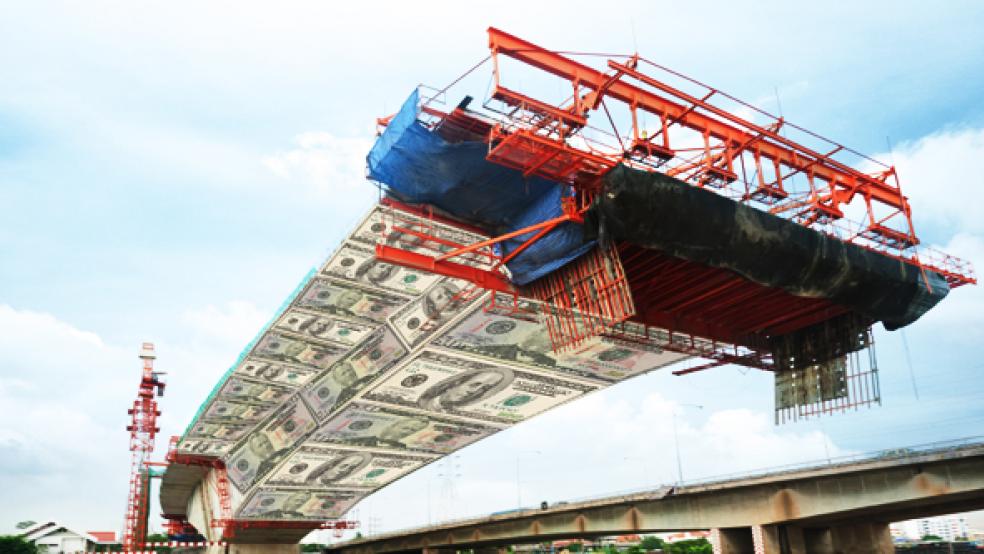The days of cheap borrowing have returned. Yields on the 10-year Treasury bond, a good benchmark for determining government borrowing costs, have fallen to the lowest level since last year’s government shutdown. Despite a severe reduction in uncertainty surrounding fiscal policy, and a generally positive trajectory on many economic indicators, including employment, the cost of borrowing remains stuck near historic lows.
Most observers expected interest rates to rise as the economy lifted off, especially when the Federal Reserve started pulling back on its quantitative easing program. So why, then, is government debt in such demand?
Related: Four Reasons the Fed Should Not Raise Interest Rates
First of all, the economy remains sluggish enough to keep a lid on interest rates. Demand remains well below trend, the housing market has grown weaker, and inflation has not approached the Federal Reserve’s 2 percent target, a serious years-long problem (there’s little difference between the Federal Reserve missing at 1.5 percent inflation and missing at 2.5 percent). Those who continually warn of an inflation monster and soul-crushing interest rate spikes just around the corner have yet to recalibrate their expectations. But the economic torpor may be enough for the Fed to keep rates low even longer than initially assumed.
In addition, while it’s hard for Americans to believe that America doesn’t drive all economic policy, many factors associated with low interest rates are external. Expected monetary easing by the European Central Bank, to avoid the risk of low inflation, has brought interest rates down throughout the world. Tensions in Ukraine make investors nervous, as does the apparent implosion of the Chinese housing bubble.
These factors have created a flight to safety to U.S. government debt, which still carries the perception of being the most secure place in the world to park your money. Despite cries from some circles about domestic fiscal instability, and even after a downgrade on government debt by Standard and Poor’s, global investors have peerless faith in the United States’ ability to repay, and whenever they get jittery, they shelter in the security of Treasury bonds.
This confluence of factors has led to the re-emergence of the biggest bargain in America, an opportunity we have squandered amid years of low interest rates. Once again, we have a chance — perhaps the last chance — to use cheap borrowing to invest in priorities that will never be this affordable again. For example, taking advantage of low rates and enacting a large infrastructure program would actually save money in the long-term, while strongly supporting economic recovery right now.
Related: Spending on Infrastructure Now Generates Long-Term Jobs later
Everyone knows that we have a significant infrastructure gap. The American Society of Civil Engineers grades the quality of our roads, bridges, dams, water systems, ports, and rail lines at a D+, and estimates that we will need $3.6 trillion in infrastructure investment between now and 2020. One in four of our bridges is structurally unsound, for example. And when a major bridge collapses, like it did earlier this month on the main road between Los Angeles and Las Vegas, you have no choice but to fix it immediately. Unexpected, emergency reconstruction increases overall costs and plays havoc with budgets.
Related: 10 Most Dangerous Infrastructure Problems
So we can wait until the last possible moment to make the necessary repairs and upgrades, or we can anticipate them and make them now, when the cost of capital is probably as low as it will get. Moreover, we can support the needs of the future, like a smart electrical grid and high-quality broadband development.
This is the optimal time. Investors are quite literally willing to pay the U.S. government to borrow money. The government should accommodate them and jump all over this negative-rate financing (if you adjust for inflation). If you believe that we will have to spend on infrastructure investment somewhere down the line — and you should — this is a fiscally conservative, not a fiscally profligate, maneuver. To make it simple, the choices are: going without blacktop and just driving alongside the river until it’s narrow enough where you can get the car across it, or actually keeping up with our infrastructure needs in the smartest way.
Related: Why Smart Leaders Would Fix Our Infrastructure Now
Growing infrastructure investment, more importantly, would support near-term job creation and higher economic growth. We can ease Larry Summers’ slightly bizarre disquiet with the state of New York’s JFK Airport, and lower the unemployment rate for construction workers, still stuck above 10 percent. We can add demand to the economy by ramping up government purchases, and we can support U.S. consumers and businesses by making it easier to move people and goods, increasing efficiency and productivity. If there’s a good reason for delay, I haven’t encountered it; it’s one of those rare areas where even labor and the Chamber of Commerce agree.
Unfortunately, my powers of persuasion are unlikely to reverse the trend in Washington. Congress has all but packed up for the year, and on infrastructure, they are moving toward depleting the Highway Trust Fund and costing the nation 700,000 jobs, not taking advantage of the low-rate environment and spending more. Sadly, spending on infrastructure sits at its lowest level since World War II.
Related: Infrastructure Spending Key to Economic Growth, Summers Says
Like many bargains, today’s low interest rates should have a sign attached saying “Act now while supplies last!” New York Federal Reserve President William Dudley delivered a speech this week that hinted at an earlier lift-off from the current zero lower bound of the federal funds rate. Despite solid arguments that now is not the time to raise rates, and despite an apparent effort at shadow monetary policy from former Fed Chair Ben Bernanke, the Fed yearns for a return to normalcy. And if global worries ease, investors will gradually pull away from Treasuries. Even a rate increase of 1 percent would cost hundreds of billions just in infrastructure borrowing.
The prospect of missing this enormous opportunity to improve the country’s physical foundation, support the economy and save money all at once should inspire outrage. Unfortunately, in America outrage is reserved for whatever ill-advised comment somebody famous makes on Twitter. If we stepped back and paid attention to the promise of low interest rates, and the chance to rebuild America, maybe we could channel that fury towards those who deserve to hear it.
Top Reads from The Fiscal Times:






